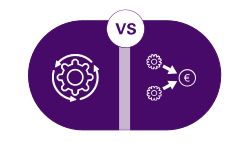We believe that striving for agility is an integral part of realizing your digital strategy. We currently see a strong uptake with an increased number of clients initiating their Agile transformation in the last three years. That being said, not every organization achieves agility in the same way. This starts with a strong grasp of the concepts of agility and how these apply on a larger scale than software development at a team level.
When organizations want to take on an Agile journey, there is no one-size fits-all way to do so. Depending on your organization’s culture, industry, willingness and readiness to change, your organization’s approach to Agile will change.
Different approaches and when to adopt them

'Big Bang’ versus incremental
- When an urgent and elaborate cultural shift is desired, a ‘Big Bang’ approach is the best option. In these situations, top management needs to be completely on board and show ongoing support for the transformation.
- When aiming for a gradual increase within certain domains of your organization, the incremental approach is the best way forward.
Top-down versus bottom-up
- KPMG observes Agile transformation driven both by IT and by C-level executives in the business.
- When driven by IT (bottom-up), main drivers for the change are enthusiasm for Agile development, DevOps & continuous delivery.
- When driven by the C-level (top-down), flexibility and speed are the main drivers. Board sponsorship becomes particularly essential when the maturity level rises above level 3.


Value driven versus one-size fits-all
- Within one organization, the applicability and necessity of speed and agility can differ between different business functions, regions or countries.
- Organizations can decide the extent to which functions are to be increased in agility from an Agile value perspective. In other cases, agility is considered equally important for the entire organization, which can result in reverting back to more traditional approaches.
Change versus Greenfields
- KPMG observes companies starting new independent initiatives outside their regular organization to experiment with Agile practices. These initiatives serve as a lighthouse project for the traditional organization and can provide the cultural motivation for a shift towards agility.
- The goal of this approach is to find and use success stories to inspire the organization and gain stakeholder buy-in.


Functional versus Value Streams
- Whereas many organizations traditionally work in functional silos, Agile only functions across these silos in multidisciplinary value streams.
- The difference between functional silos & multidisciplinary value streams is both organizational and cultural. Combining these two can be a challenge.
- The Agile journey can start with functional silos and then move towards value streams, or by introducing new value streams from the start.

The Agile journey: an example
An Agile transformation does not happen overnight. Different steps will need to be taken on your way to unlocking your target agility. This is what we call ‘The Agile Journey’.
As mentioned above, there is no one-size fits-all approach in your Agile transformation. Each organization needs to determine its own customized path to agility and select the approach best suited for its culture, industry, and readiness to change. Having said this, we do see some steps re-occurring along the Agile journeys that we have supported. An example of such an Agile journey is provided below.

1. Initiate Experimentation & Pilots
In order to determine which level of agility is right for your organization, an Agile pilot can be implemented. This pilot typically includes a small group of people working on a small initiative and applying the Agile methodology. Agile pilots need to receive full support and should be granted a certain tolerance level for failure under the philosophy of a “fail fast” approach. It’s important that in the beginning of this Agile Journey, an open mindset of experimentation is encouraged for all involved.
2. Define Agile as important and realize engagement.
In the next step of the journey, once a successful pilot is completed, a common understanding of the vision of Agile should be established. It is important to know that a successful Agile journey does not only require organizational governance changes, but it requires that the Agile ambition is reflected in the organization’s vision as well. The importance and scope of Agile should be clearly reflected throughout the organization and involving all stakeholders in this journey is of the highest importance.
3. Set up structure to implement agility
Once the journey has kicked off and the cultural shift has stared, the level of Agile maturity can be assessed and monitored. This maturity will not only cover technical aspects of agility such as software development or continuous deployment, but also cultural aspects such as teamwork and performance management. By defining a target state, an implementation roadmap can be set out to grow the Agile maturity over time.
4. Continuously & iteratively execute the agility cycle
Once an implementation roadmap has been identified based on the current level of Agile maturity, the Agile journey will continue with an iterative execution of all the previous steps. To raise the maturity to the desired level, new experimentation areas or pilot teams can be designed. If necessary, the envisioned agility can be renewed or the scope of Agile can be adapted. Next, the maturity will be reassessed, and a new implementation plan can be defined. And the cycle goes on and on.
The Agile Journey: a continuous cycle
It is important to note that the last step of your Agile journey is an iterative improvement cycle. This allows you to continuously assess and grow the level of maturity to reach the organization’s Agile vision.
At the end of this Agile journey, the iterative improvement cycle will make sure you keep continuously assessing and increasing the maturity level. Additionally, it is important to re-evaluate your organization’s Agile vision when necessary, as well to make sure your Agile set up keeps you fit for the future.
Lastly, as in every large transformation, the cultural aspect in each step of the Agile journey is of utmost importance. A fundamental part of the journey is that leadership should express their full support and make sure all employees are comfortable and feel included.
Some important factors that lead to success
No matter which approach to the Agile journey you take, Agile transformations involve many changes for the organization. These changes are often hard to embed in the organization. To ensure a successful transition to this new way of working, several key success factors can be monitored.
Agile servant leadership style
The Agile way of working requires leaders to adopt a servant leadership style, helping teams grow within the framework and perform as highly as possible. The role of leaders moves from giving orders and strictly following up on them to enabling self-steering people and teams, focusing on providing the teams with the knowledge and tools they need to succeed and continuously offering them help to resolve any impediments they encounter. Moving decision-making from upper management to the place where most of the work is done will allow for faster and easier decision-making. This not only removes bottlenecks, but also brings more knowledge and experience into the decision-making process.
From measuring a team’s delivery to measuring teams’ growth
Traditional ways of working include classical measures of staff performance, where leaders measure staff based on what they’ve delivered. The Agile leadership concept moves from measuring teams’ delivery to measuring teams’ growth. For employees to grow, leaders need to motivate them to get out of their comfort zone. It is the leader’s responsibility to create a safe space to for their teams to deal with the fear of new. The collaboration of diverse points of view creates new knowledge and this puts a focus on people, culture and diversity in Agile organizations.
Ensure sponsorship from management and engage employees
Transforming into an Agile organization will require the engagement of the top-end managers for employees to accept the case for change and a new vision. Getting leaders’ buy-in is essential to the success of the transformation. Leaders need to lead by example and become true advocates of change. Engaging employees might not be an easy task, as Agile is often seen as an invasive interruption of the current way of working and the current control people have over their activities. Addressing staff concerns and explaining the vision and reason behind the transformation should put them at ease and give them the necessary motivation and engagement. Providing adequate communication with every step that is taken and coaching people in their new roles has been found to be successful in getting employees on board.




